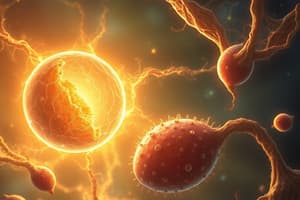Podcast
Questions and Answers
What is the term for the loss of a segment of a chromosome?
What is the term for the loss of a segment of a chromosome?
- Deletion (correct)
- Mutation
- Insertion
- Translocation
At what week of human embryo development do the primordial gonadal cells (PGC) migrate from the yolk sac to the genital ridges?
At what week of human embryo development do the primordial gonadal cells (PGC) migrate from the yolk sac to the genital ridges?
- 5 weeks
- 3 weeks
- 4 weeks (correct)
- 2 weeks
What is the result of the activation of the SRY gene in the development of the male gonad?
What is the result of the activation of the SRY gene in the development of the male gonad?
- Formation of the yolk sac
- Formation of the testis (correct)
- Formation of the ovary
- Formation of the genital ridge
What is the process by which immature oocytes are distributed throughout the ovary in follicles?
What is the process by which immature oocytes are distributed throughout the ovary in follicles?
How many follicles are present in each human ovary?
How many follicles are present in each human ovary?
What is the location of primordial follicles in the ovary?
What is the location of primordial follicles in the ovary?
What is the result of the differentiation of primordial germ cells into an unfertilized egg?
What is the result of the differentiation of primordial germ cells into an unfertilized egg?
What is the syndrome caused by the deletion of a segment of chromosome 5?
What is the syndrome caused by the deletion of a segment of chromosome 5?
What is the process by which the number of chromosomes is reduced in gametogenesis?
What is the process by which the number of chromosomes is reduced in gametogenesis?
What is the term for the union of male and female gametes?
What is the term for the union of male and female gametes?
What is the term for the process of converting germ cells into male and female gametes?
What is the term for the process of converting germ cells into male and female gametes?
In which layer of the yolk sac do germ cells originate from?
In which layer of the yolk sac do germ cells originate from?
What is the term for the phenomenon where a part of a chromosome breaks off and attaches to another?
What is the term for the phenomenon where a part of a chromosome breaks off and attaches to another?
What is the result of non-disjunction during meiosis?
What is the result of non-disjunction during meiosis?
How many phases are there in gametogenesis?
How many phases are there in gametogenesis?
What is the haploid number of chromosomes in a gamete?
What is the haploid number of chromosomes in a gamete?
Flashcards are hidden until you start studying
Study Notes
Gametogenesis
- Gametogenesis is the conversion of germ cells into male and female gametes, resulting in the formation of sperm and oocytes
- It involves four phases: origin and migration of germ cells, increase in number of germ cells by mitosis, reduction in chromosomal number by meiosis, and structural and functional maturation of eggs and sperm
Oogenesis
- Oogenesis is the process of formation of female gametes (oocytes)
- Immature oocytes are distributed throughout the ovary in follicles, with a total of 200,000 to 400,000 follicles present in each human ovary
- Each follicle contains a single oogonium
- Few oogonia reach maturity, with typically fewer than 400 oocytes maturing and being released by ovulation
- Location of oocyte depends on its maturity, with primordial follicles most prevalent in the stroma (near the outside) and oocytes becoming more centrally located as they mature
- Primordial germ cells migrate to the ovary during fetal and embryonic development
- Differentiation of primordial germ cell into an unfertilized egg requires proliferation and growth in size
Mitosis and Meiosis
- Mitosis is a process where a cell divides into two daughter cells that are genetically identical to the parent cell
- Meiosis occurs in germ cells and involves two cell divisions, Meiosis I and Meiosis II, to produce gametes
- Meiosis I reduces the number of chromosomes by half, and Meiosis II separates the sister chromatids
Chromosomal Abnormalities
- Numerical chromosomal abnormalities occur due to non-disjunction, leading to trisomy (three copies of a chromosome) or monosomy (one copy of a chromosome)
- Structural chromosomal abnormalities do not affect the total chromosome number but have serious consequences, such as translocation (where a part of a chromosome breaks off and is attached to another) or deletion (where a segment of a chromosome is lost)
- Deletion can lead to syndromes, such as Cri-du-chat syndrome (which occurs at chromosome 5)
Studying That Suits You
Use AI to generate personalized quizzes and flashcards to suit your learning preferences.




